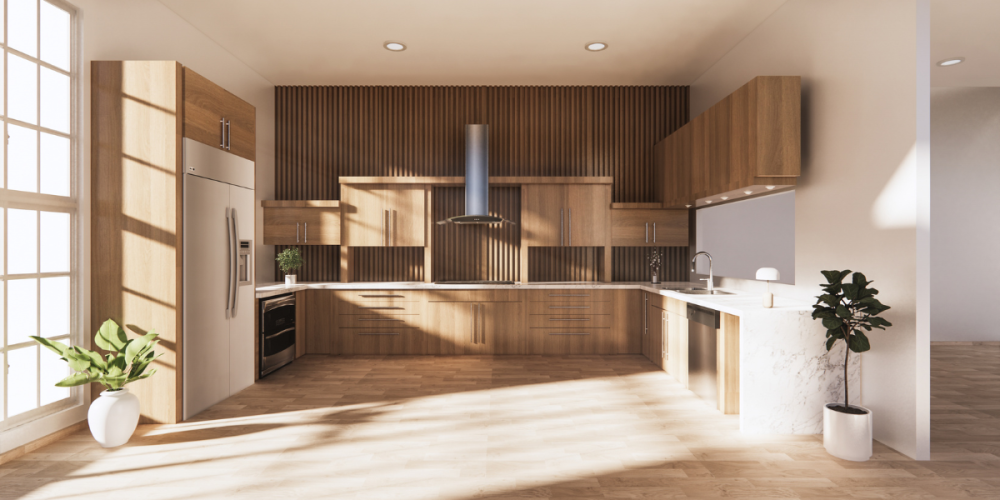Undergoing a kitchen remodel can be an exciting yet challenging time. Your kitchen, the heart of your home, is temporarily out of commission. Where will you prep meals, wash dishes, store food, or even make your morning coffee? Having a plan to create a temporary kitchen setup is key to surviving a remodel with your sanity intact.
Assess Your Temporary Kitchen Needs
Before demolition day, take stock of what you currently use your kitchen for daily. Make a list so you know what key items you need access to. Here are some considerations:
- Where will you wash dirty dishes?
- Do you need access to a sink for washing hands, fruits/veggies, etc?
- Where will you store perishable foods like milk, eggs, cheese, etc?
- Do you use any small countertop appliances like a coffee maker, toaster oven, or microwave regularly?
Knowing your must-have amenities will help you plan an adequate temporary kitchen. Identifying these needs ahead of time also allows you to budget any potential additional costs for items you may need to function during this time.
Create a Temporary Kitchen Sink
One of the biggest challenges during a kitchen remodel is the lack of access to your kitchen sink. The sink is used countless times per day for washing dishes, preparing food, cleaning veggies, brushing teeth, and much more.
Some effective options for temporary kitchen sinks include:
Bathroom Sink
For some, the bathroom sink may provide an adequate substitute for light kitchen sink needs. It likely doesn’t provide the space needed to wash larger items such as pots and baking sheets. But for hand washing and very light food prep, you may be able to make do with just your bathroom sink.
Laundry Sink
Many laundry rooms provide a practical second sink option during a remodel. Laundry sinks are often larger/deeper than a bathroom sink allowing you to wash larger dirty dishes. Some even have a small countertop area next to the sink for temporary food prep. Just be mindful that your laundry sink will need much more frequent cleaning to keep sanitary when being utilized for kitchen purposes.
Temporary Utility Sink
For those needing serious sink space, investing in a temporary utility sink is worth considering. They are available in a range of sizes, are typically on locking casters for portability, and include utility hookups needed to make installation simple. Go for one with both hot and cold water if possible.
Make Dirty Dishes More Manageable
No matter which sink option you utilize, washing a full load of dirty dishes will be more challenging during this timeframe. Here are some tips to make your makeshift kitchen setup:
- Stock up on paper plates and plastic utensils. Use them as much as possible to minimize daily dishwashing.
- Look into temporary dish carts with built-in gray water tanks. These handy carts allow you to wash dishes in one area while transporting water away to be dumped out.
- Get a plastic bin. Let them accumulate for 1-2 days and then tackle washing all at once when you have time.
- Use heavy-duty aluminum pans. They clean up nicely outside using just hot water and no sink access is needed.
Create Temporary Food Prep Areas
You likely utilize your kitchen countertops constantly when prepping meals. Losing this space means getting creative with temporary food prep solutions. Here are some good options:
Plastic Folding Table
A 6-8 ft plastic folding table offers excellent temporary countertop space. Look for sturdy banquet-style tables that can handle heavy usage. Using folding tables allows you to easily set up your makeshift kitchen in whatever room makes most sense, and stores out of the way when not in use.
Butcher Block Carts
Another portable option for food prep is to utilize a butcher block cart or island. Many come with storage and locking casters. Butcher block tops provide plenty of secure surface area for chopping veggies or kneading dough.
Use Adjacent Countertops
Make the most of fixed countertop work areas in rooms adjacent to the kitchen. This may mean setting up a temporary prep zone on bathroom counters, laundry room floors, basement workbenches, or garage shelving units.
Critical Small Appliances
While your full-sized appliances are off-limits, you’ll still need access to smaller kitchen gadgets used regularly. Have a plan for these:
Coffee Maker
For some, functioning without coffee is not an option. Set up your coffee maker on a secure surface and make sure you have outlets accessible. Measure cord length to outlet ahead of time if placed in a new area.
Electric Kettle
An electric kettle can serve many purposes from making hot tea, instant oats, or pot noodles. They take up minimal space and can be easily moved around as needed.
Toaster Oven
A small countertop toaster oven lets you bake, broil, or toast essentials during the renovation timeframe. They are smaller and vent well to use in non-kitchen areas.
Hot Plate
A portable induction cooktop or electric hot plate allows you to cook small meals. They take up minimal counter space and provide quick cooking functionality.
Electric Griddle
An electric griddle opens up cooking options letting you make pancakes, grilled sandwiches, fajitas, and more. Just be mindful of your circuit capacity based on the location used.
Keep Essential Kitchen & Food Supplies Accessible
You likely use a variety of kitchen tools, cooking utensils, pantry goods, and cleaning supplies daily. Keep these items easily accessible:
- Kitchen items – Can opener, measuring cups/spoons, mixing bowls, baking sheets, pots/pans, home-cooked meal spices, foil, storage bags
- Food & Condiments – Non-perishables, staple ingredients, fridge/freezer items, butter, oils, vinegar, sauces
- Cleaning – Dish soap, sponges, dish rack, towels, scrub brushes, gloves, trash bags
Find temporary homes for these items in rooms near your makeshift kitchen setup. Dedicate shelves, plastic bins, or caddies. This avoids constantly needing to hunt down necessities.
Temporary Fridge & Freezer Replacements
Larger refrigeration is tough to replace during a remodel temporarily. Focus solutions on properly storing perishable items. Useful options include:
Extra Mini Fridges
Supplement your main refrigerator with extra smaller units. Fridges and freezers come in a range of sizes these days. You can often find multi-unit deals by shopping sales.
Coolers
For those without space or budget for more refrigeration, rely on coolers. Use them to store cold items and drinks adding fresh ice 1-2 times per day. This isn’t ideal long-term, but can work for shorter 1-2 week remodels.
Freeze Ahead
Plan dishes that freeze well and prep them ahead of your remodel. Casseroles, lasagnas, soups, and chili all freeze nicely. Thaw items out as needed on your temporary food prep area or surfaces.
Where to Set Up Your Temporary Kitchen
Finding the right area to create your temporary, makeshift kitchen takes some thought. Consider these aspects when selecting an alternative kitchen location:
- Proximity – Choose a space as close as possible to your kitchen.
- Power – Ensure ample outlets in the area for small appliances.
- Water Access – Nearby sink access is ideal.
- Cleanliness – Select an area that is easy to keep sanitized.
- Traffic Flow – Pick a setup that won’t cause congestion with remodel crews.
- Size – Have enough space to operate plus store supplies.
Based on your home layout, some suitable spots may include a laundry room, mudroom, basement, garage, enclosed porch, or even bathroom. Get creative!
Embrace the Simple Things
Attempting elaborate home-cooked meals without your fully functioning kitchen will likely end in frustration. Embrace simple shortcuts during this transitional period.
Some ideas include:
- Takeout – No shame in ordering your favorites!
- Grilled cheese & soup – Quick stovetop meals
- Salads & cold plates – No heavy cooking
- Quesadillas & nachos – Fast griddle options
- Cereal & breakfast bars – Easy morning meals
- Sandwiches – Endless fresh fillings & combos
The demolition dust will settle soon enough. In the meantime, go easy on yourself!
Pack a “Necessities” Bag
No matter how prepared you think you are, there will inevitably be something you suddenly need that has been packed away. Pack a bag with these so they are quickly accessible:
- Scissors
- Tape measure
- Basic tools (hammer, screwdriver, etc)
- Pens/paper
- First aid kit
Throw in any other random items you find yourself needing daily as you discover them.
FAQs
How do you survive a kitchen renovation?
Make sure to create a temporary setup in another part of your home for essential kitchen activities such as food preparation and cooking. Stock up on non-perishable food items, meal kits, or ready-to-eat meals to minimize the need for elaborate cooking preparations. Plan and organize your meals in advance to ensure efficient use of limited resources during the renovation.
How do people cook during a kitchen remodel?
Utilize alternative stoves like portable electric cookers, slow cookers, or microwave ovens that can be set up in a temporary makeshift kitchen area. Opt for outdoor grilling or barbecue if weather permits. Consider ordering takeout or delivery services from local restaurants to alleviate the burden of cooking responsibilities during the remodel.
How to do dishes during a kitchen remodel?
Use disposable plates, cups, and cutlery as much as possible to reduce the amount of dishwashing needed. If washing by hand is necessary, designate a small sink or basin with running water for this purpose. Make sure to use dish detergent specifically formulated for easy rinsing in case your regular sink is not accessible. Maximize the use of plastic wrap, sealable bags, or Tupperware containers.
Conclusion
Remodeling your kitchen is a messy, noisy, and chaotic transition – but soon you’ll have your dream space! Planning helps ease the challenges of day-to-day survival without this pivotal room. Get creative with temporary workarounds to bridge the gap during this time. Embrace the simple joys of takeout and sandwiches. Before you know it, you’ll be enjoying home-cooked meals in your brand-new, gorgeous kitchen!


























